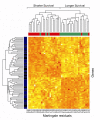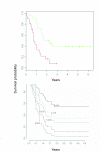A gene expression signature associated with survival in metastatic melanoma
- PMID: 17129373
- PMCID: PMC1697826
- DOI: 10.1186/1479-5876-4-50
A gene expression signature associated with survival in metastatic melanoma
Abstract
Background: Current clinical and histopathological criteria used to define the prognosis of melanoma patients are inadequate for accurate prediction of clinical outcome. We investigated whether genome screening by means of high-throughput gene microarray might provide clinically useful information on patient survival.
Methods: Forty-three tumor tissues from 38 patients with stage III and stage IV melanoma were profiled with a 17,500 element cDNA microarray. Expression data were analyzed using significance analysis of microarrays (SAM) to identify genes associated with patient survival, and supervised principal components (SPC) to determine survival prediction.
Results: SAM analysis revealed a set of 80 probes, corresponding to 70 genes, associated with survival, i.e. 45 probes characterizing longer and 35 shorter survival times, respectively. These transcripts were included in a survival prediction model designed using SPC and cross-validation which allowed identifying 30 predicting probes out of the 80 associated with survival.
Conclusion: The longer-survival group of genes included those expressed in immune cells, both innate and acquired, confirming the interplay between immunological mechanisms and the natural history of melanoma. Genes linked to immune cells were totally lacking in the poor-survival group, which was instead associated with a number of genes related to highly proliferative and invasive tumor cells.
Figures



Similar articles
-
Gene expression profiling of primary cutaneous melanoma and clinical outcome.J Natl Cancer Inst. 2006 Apr 5;98(7):472-82. doi: 10.1093/jnci/djj103. J Natl Cancer Inst. 2006. PMID: 16595783
-
Distinct molecular mechanisms underlying clinically relevant subtypes of breast cancer: gene expression analyses across three different platforms.BMC Genomics. 2006 May 26;7:127. doi: 10.1186/1471-2164-7-127. BMC Genomics. 2006. PMID: 16729877 Free PMC article.
-
Predicting clinical outcome through molecular profiling in stage III melanoma.Clin Cancer Res. 2008 Aug 15;14(16):5173-80. doi: 10.1158/1078-0432.CCR-07-4170. Clin Cancer Res. 2008. PMID: 18698035
-
In vivo switching of human melanoma cells between proliferative and invasive states.Cancer Res. 2008 Feb 1;68(3):650-6. doi: 10.1158/0008-5472.CAN-07-2491. Cancer Res. 2008. PMID: 18245463
-
Gene expression profiling of primary cutaneous melanoma.Verh K Acad Geneeskd Belg. 2007;69(1):23-45. Verh K Acad Geneeskd Belg. 2007. PMID: 17427873 Review.
Cited by
-
Patterns of expression of DNA repair genes and relapse from melanoma.Clin Cancer Res. 2010 Nov 1;16(21):5211-21. doi: 10.1158/1078-0432.CCR-10-1521. Epub 2010 Aug 12. Clin Cancer Res. 2010. PMID: 20705614 Free PMC article.
-
Immunomagnetic-Enriched Subpopulations of Melanoma Circulating Tumour Cells (CTCs) Exhibit Distinct Transcriptome Profiles.Cancers (Basel). 2019 Jan 30;11(2):157. doi: 10.3390/cancers11020157. Cancers (Basel). 2019. PMID: 30769764 Free PMC article.
-
Immunologic biomarkers as correlates of clinical response to cancer immunotherapy.Cancer Immunol Immunother. 2011 Mar;60(3):433-42. doi: 10.1007/s00262-010-0960-8. Epub 2011 Jan 8. Cancer Immunol Immunother. 2011. PMID: 21221967 Free PMC article. Review.
-
TYRP1 mRNA expression in melanoma metastases correlates with clinical outcome.Br J Cancer. 2011 Nov 22;105(11):1726-32. doi: 10.1038/bjc.2011.451. Epub 2011 Nov 1. Br J Cancer. 2011. PMID: 22045183 Free PMC article.
-
Reprogramming human A375 amelanotic melanoma cells by catalase overexpression: Upregulation of antioxidant genes correlates with regression of melanoma malignancy and with malignant progression when downregulated.Oncotarget. 2016 Jul 5;7(27):41154-41171. doi: 10.18632/oncotarget.9273. Oncotarget. 2016. PMID: 27206673 Free PMC article.
References
-
- Homsi J, Kashani-Sabet M, Messina JL, Daud A. Cutaneous melanoma: prognostic factors. Cancer Control. 2005;12:223–229. - PubMed
-
- Balch CM, Buzaid AC, Soong SJ, Atkins MB, Cascinelli N, Coit DG, Fleming ID, Gershenwald JE, Houghton A, Jr., Kirkwood JM, McMasters KM, Mihm MF, Morton DL, Reintgen DS, Ross MI, Sober A, Thompson JA, Thompson JF. Final version of the American Joint Committee on Cancer staging system for cutaneous melanoma. J Clin Oncol. 2001;19:3635–3648. - PubMed
-
- Balch CM, Soong SJ, Gershenwald JE, Thompson JF, Reintgen DS, Cascinelli N, Urist M, McMasters KM, Ross MI, Kirkwood JM, Atkins MB, Thompson JA, Coit DG, Byrd D, Desmond R, Zhang Y, Liu PY, Lyman GH, Morabito A. Prognostic factors analysis of 17,600 melanoma patients: validation of the American Joint Committee on Cancer melanoma staging system. J Clin Oncol. 2001;19:3622–3634. - PubMed
-
- Weyers W, Euler M, Diaz-Cascajo C, Schill WB, Bonczkowitz M. Classification of cutaneous malignant melanoma: a reassessment of histopathologic criteria for the distinction of different types. Cancer. 1999;86:288–299. doi: 10.1002/(SICI)1097-0142(19990715)86:2<288::AID-CNCR13>3.0.CO;2-S. - DOI - PubMed
LinkOut - more resources
Full Text Sources
Other Literature Sources

